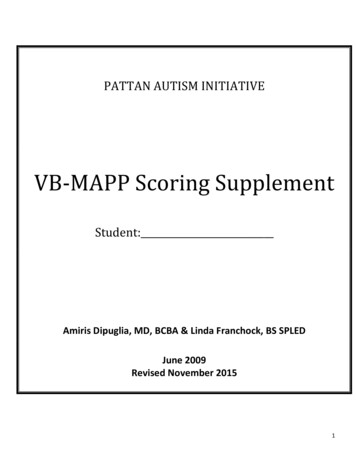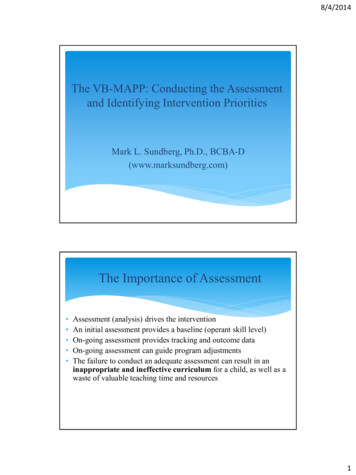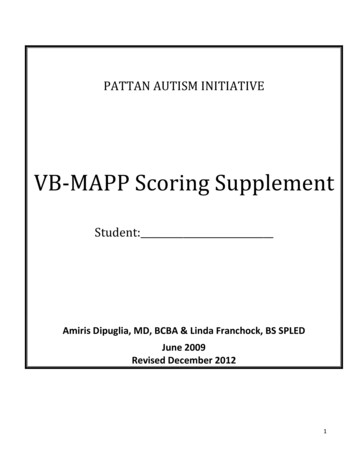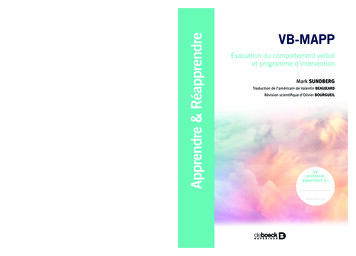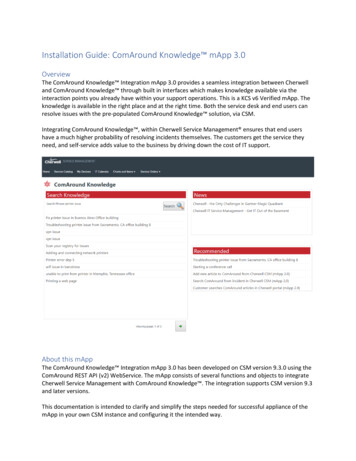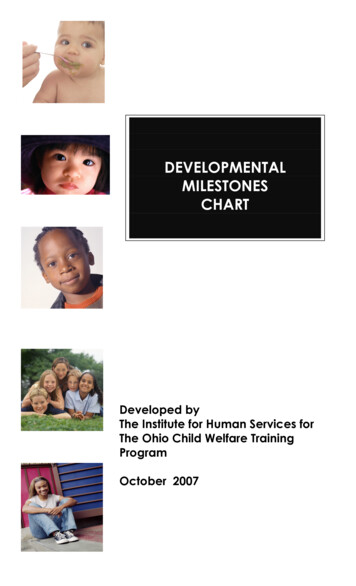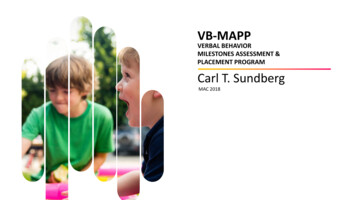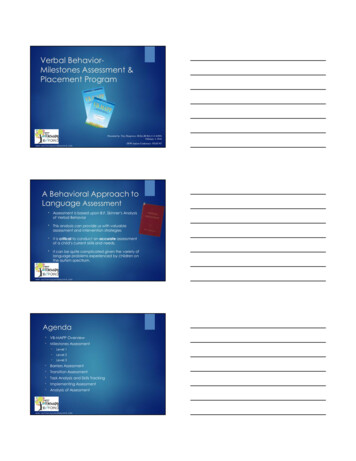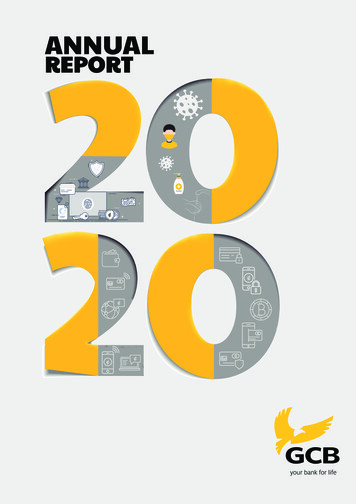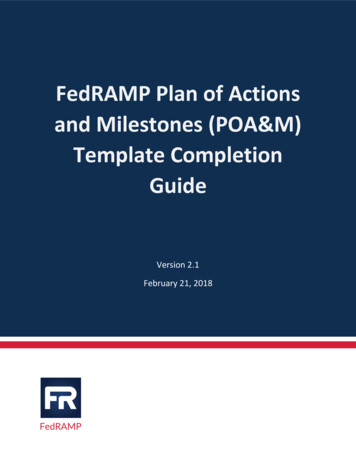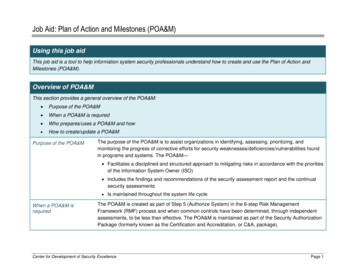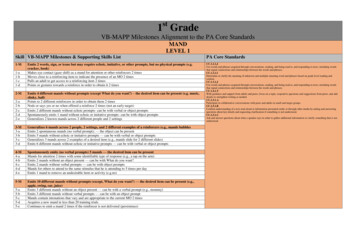
Transcription
st1 GradeVB-MAPP Milestones Alignment to the PA Core StandardsMANDLEVEL 1Skill VB-MAPP Milestones & Supporting Skills ListPA Core Standards1-MCC.1.2.1.JUse words and phrases acquired through conversations, reading, and being read to, and responding to texts, including wordsthat signal connections and relationships between the words and phrases.CC.1.3.1.IDetermine or clarify the meaning of unknown and multiple-meaning word and phrases based on grade level reading andcontent.CC.1.3.1.JUse words and phrases acquired through conversations, reading, and being read to, and responding to texts, including wordsthat signal connections and relationships between the words and phrases.CC.1.4.1.TWith guidance and support from adults and peers, focus on a topic, respond to questions and suggestions from peers, and adddetails to strengthen writing as needed.CC.1.5.1.AParticipate in collaborative conversations with peers and adults in small and larger groups.CC.1.5.1.BConfirm understanding of a text read aloud or information presented orally or through other media by asking and answeringquestions about key details and requesting clarification if something is not understood.CC.1.5.1.CAsk and answer questions about what a speaker says in order to gather additional information or clarify something that is notunderstood.1-a1-b1-c1-dEmits 2 words, sign, or icons but may require echoic, imitative, or other prompts, but no physical prompts (e.g.cracker, book)Makes eye contact (gaze shift) as a mand for attention or other reinforcers 2 timesMoves close to a reinforcing item to indicate the presence of an MO 2 timesPulls an adult to get access to a reinforcing item 2 timesPoints or gestures towards a reinforce in order to obtain it 2 times2-a2-b2-c2-d2-eEmits 4 different mands without prompts (except What do you want?) – the desired item can be present (e.g. music,slinky, ball)Points to 2 different reinforcers in order to obtain them 2 timesNods or says yes or no when offered a reinforce 2 times (not an early target)Emits 2 different mands without echoic prompts- can be with verbal or object promptsSpontaneously emits 1 mand without echoic or imitative prompts- can be with object promptsGeneralizes 2 known mands across 2 different people and 2 settings3-M3-a3-b3-c3-dGeneralizes 6 mands across 2 people, 2 settings, and 2 different examples of a reinforcers (e.g., mands bubblesEmits 2 spontaneous mands (no verbal prompt); — the object can be presentEmits 5 mands without echoic or imitative prompts — can be with verbal or object promptsGeneralizes 3 mands across 2 examples of a desired item (e.g., mands slide for 2 different slides)Emits 6 different mands without echoic or imitative prompts — can be with verbal or object prompts4-M4-a4-b4-c4-d4-eSpontaneously emits (no verbal prompts) 5 mands — the desired item can be presentMands for attention 2 times with some identifiable type of response (e.g., a tap on the arm)Emits 2 mands without an object present — can be with What do you want?Emits 2 mands without verbal prompts — can be with object promptsMands for others to attend to the same stimulus that he is attending to 5 times per dayEmits 1 mand to remove an undesirable item or activity (e.g.no)5-MEmits 10 different mands without prompts (except, What do you want?) — the desired item can be present (e.g.,apple, swing, car, juice)Emits 3 different mands without an object present — can be with a verbal prompt (e.g., mommy)Emits 3 different mands without verbal prompts — can be with an object promptMands contain intonations that vary and are appropriate to the current MO 2 timesAcquires a new mand in less than 20 training trialsContinues to emit a mand 2 times if the reinforcer is not delivered (persistence)2-M5-a5-b5-c5-d5-e
MANDLEVEL 2Skill VB-MAPP Milestones & Supporting Skills ListPA Core Standards6-MCC.1.3.1.IDetermine or clarify the meaning of unknown and multiple-meaning word and phrases based on grade level reading andcontent.CC.1.5.1.BConfirm understanding of a text read aloud or information presented orally or through other media by asking and answeringquestions about key details and requesting clarification if something is not understood.CC.1.5.1.CAsk and answer questions about what a speaker says in order to gather additional information or clarify something that is notunderstood.CC.2.7.1.BPredict and explain the outcomes of events.CC.2.7.1.DList or graph the possible results of an experiment.CC.2.7.1.EAnswer questions about predictions and actual outcomes based on data.CC.2.8.1.AUse the concept of equality and concrete objects to demonstrate understanding of the commutative and associative properties.CC.2.8.1.BUse concrete objects and trial and error to solve number sentences.CC.2.8.1.DUse a rule to find a missing addend or symbol to make a number sentence true, with adult assistance.CC.2.8.1.FDescribe and answer questions about data from classroom graphs and charts.CC.1.3.1.IDetermine or clarify the meaning of unknown and multiple-meaning word and phrases based on grade level reading andcontent.CC.1.4.1.TWith guidance and support from adults and peers, focus on a topic, respond to questions and suggestions from peers, and adddetails to strengthen writing as needed.CC.1.5.1.BConfirm understanding of a text read aloud or information presented orally or through other media by asking and answeringquestions about key details and requesting clarification if something is not understood.CC.1.5.1.CAsk and answer questions about what a speaker says in order to gather additional information or clarify something that is 7-g8-M8-a8-b8-c8-d8-e8-fMands for 20 different missing items without prompts (except e.g., What do you need?) (e.g., mands for paper whengiven a crayonSpontaneously emits 5 mands without an object present and without verbal promptsEmits 10 different mands without echoic or imitative prompts — object can be presentMands for 5 different missing items without prompts (except a verbal prompt)Generalizes 4 mands to 4 different peopleMaintains a newly acquired mand for a missing item after 24 hours of no contact with the itemMands for others to emit 5 different actions needed to enjoy a desired activity (e.g., open to get outside, push when ona swing)Mands 2 times with 2 words in a phrase or sentence (e.g., Drink juice.)Mands for other individuals to emit 2 different actions with verbal prompts (e.g., go, spin)Emits 2 mands to remove undesirable items or activitiesDemonstrates response generalization for two different mands (e.g., calls a filled cup both cup and drink; calls a dog bothdog and Maggie)Mands contain varied intonation appropriate to both positive and negative MOs 5 timesMands for help or assistance 2 timesDemonstrates a high frequency of manding (15 in a 5 minute period)Emits 5 different mands that contain 2 or more words (not including I want) (e.g., Go fast. My turn. Pour juice.) (TO:60 min.)Mands 5 times with 2 words in a phrase or sentenceMands for information 2 times using what questions (e.g., What’s that?)Mands with a pronoun 2 times (e.g., My train. That’s yours.)Mands occur with 3 different carrier phrases (e.g., I want It’s my. Can I That’s my.)Mands with yes and no 4 times (e.g., Do you want a ride? Yes.)Mands for information 2 times using where questions (e.g., Where’s Elmo?)CC.1.2.1.JUse words and phrases acquired through conversations, reading, and being read to, and responding to texts, including wordsthat signal connections and relationships between the words and phrases.CC.1.3.1.IDetermine or clarify the meaning of unknown and multiple-meaning word and phrases based on grade level reading andcontent.CC.1.3.1.JUse words and phrases acquired through conversations, reading, and being read to, and responding to texts, including wordsthat signal connections and relationships between the words and phrases.CC.1.5.1.BConfirm understanding of a text read aloud or information presented orally or through other media by asking and answeringquestions about key details and requesting clarification if something is not understood.CC.1.5.1.C
Ask and answer questions about what a speaker says in order to gather additional information or clarify something that is notunderstood.9-M9-a9-b9-c9-d9-e9-fSpontaneously emits 15 different mands (e.g., Let’s play. Open. I want book.)Spontaneously emits 50 mands per day (can be with objects present, but without verbal prompts)Acquires 2 mands from tact or echoic only training (e.g., sees and tacts a live giraffe, and later mands to go back to see thegiraffe)Mands for information 25 times using any type of question wordMands with an adjective 5 times (e.g., big chip, red car)Emits 5 mands in 30 seconds (e.g., during a game or fun activity such as water play)Mands contain 3-word phrases 10 times (e.g., That’s my horse.)10-MEmits 10 new mands without specific mand training (e.g., spontaneously says Where kitty go? without formal mandtraining)10-a10-b10-c10-d10-e10-fEmits 2 new mands without training (e.g., says I want hot cocoa without training)Demonstrates response generalization for 2 different mands (e.g., Get me. Chase me. Run.)Mands with an adjective 5 times — can use verbal and nonverbal promptsMands for information 3 times using who questionsSpontaneously mands for others to emit 20 different actions (e.g., Run. Go. Push me.)Spontaneously mands to novel and unfamiliar people 2 timesCC.1.2.1.JUse words and phrases acquired through conversations, reading, and being read to, and responding to texts, including wordsthat signal connections and relationships between the words and phrases.CC.1.3.1.JUse words and phrases acquired through conversations, reading, and being read to, and responding to texts, including wordsthat signal connections and relationships between the words and phrases.CC.1.5.1.BConfirm understanding of a text read aloud or information presented orally or through other media by asking and answeringquestions about key details and requesting clarification if something is not understood.CC.1.5.1.CAsk and answer questions about what a speaker says in order to gather additional information or clarify something that is notunderstood.CC.2.8.1.FDescribe and answer questions about data from classroom graphs and charts.CC.1.2.1.JUse words and phrases acquired through conversations, reading, and being read to, and responding to texts, including wordsthat signal connections and relationships between the words and phrases.CC.1.3.1.IDetermine or clarify the meaning of unknown and multiple-meaning word and phrases based on grade level reading andcontent.CC.1.3.1.JUse words and phrases acquired through conversations, reading, and being read to, and responding to texts, including wordsthat signal connections and relationships between the words and phrases.CC.1.5.1.BConfirm understanding of a text read aloud or information presented orally or through other media by asking and answeringquestions about key details and requesting clarification if something is not understood.CC.1.5.1.CAsk and answer questions about what a speaker says in order to gather additional information or clarify something that is notunderstood.MANDLEVEL 3Skill VB-MAPP Milestones & Supporting Skills List11-M11-a11-b11-c11-d11-eSpontaneously mands for different verbal information using a WH question or question word 5 times (e.g., What’syour name? Where do I go?)Mands to peers 5 timesSpontaneously mands for attention 5 times (e.g., Teacher! Hey! Excuse me.)The child emits 100 or more different mands in a one week periodMands contain 3-word phrases 10 times (e.g, Can I see?)Mands for a specific quantity of reinforcers 2 times (e.g., two gummy bears)PA Core StandardsCC.1.3.1.BAsk and answer questions about key details in a text.CC.1.3.1.IDetermine or clarify the meaning of unknown and multiple-meaning word and phrases based on grade level reading andcontent.CC.1.3.1.JUse words and phrases acquired through conversations, reading, and being read to, and responding to texts, including wordsthat signal connections and relationships between the words and phrases.CC.1.4.1.TWith guidance and support from adults and peers, focus on a topic, respond to questions and suggestions from peers, and adddetails to strengthen writing as needed.
12-MCC.1.5.1.AParticipate in collaborative conversations with peers and adults in small and larger groups.CC.1.5.1.BConfirm understanding of a text read aloud or information presented orally or through other media by asking and answeringquestions about key details and requesting clarification if something is not understood.CC.1.5.1.CAsk and answer questions about what a speaker says in order to gather additional information or clarify something that is notunderstood.CC.2.7.1.BPredict and explain the outcomes of events.CC.2.7.1.DList or graph the possible results of an experiment.CC.2.7.1.EAnswer questions about predictions and actual outcomes based on data.CC.2.8.1.AUse the concept of equality and concrete objects to demonstrate understanding of the commutative and associative properties.CC.2.8.1.BUse concrete objects and trial and error to solve number sentences.CC.2.8.1.DUse a rule to find a missing addend or symbol to make a number sentence true, with adult assistance.CC.2.8.1.FDescribe and answer questions about data from classroom graphs and charts.CC.1.5.1.BConfirm understanding of a text read aloud or information presented orally or through other media by asking and answeringquestions about key details and requesting clarification if something is not understood.CC.2.7.1.BPredict and explain the outcomes of events.12-ePolitely mands to stop an undesirable activity or remove any aversive MO under 5 different circumstances (e.g.,Please stop pushing me. No thank you. Excuse me, can you move?)Mands to remove an aversive item or activity 2 times (e.g., Let go. Give it back.)Mands for others to perform a two-step action 2 times (e.g., Come
Skill VB-MAPP Milestones & Supporting Skills List PA Core Standards 1-M CC.1.2.1.JEmits 2 words, sign, or icons but may require echoic, imitative, or other prompts, but no physical prompts (e.g. cracker, book) Use words and phrases acquired through conversations, reading, and being read to, and responding to texts, including words that signal connections and relationships between the words and .
